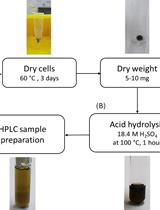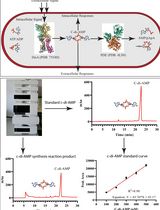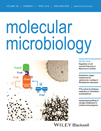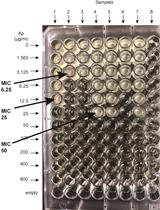- EN - English
- CN - 中文
Measurement of Cellular Copper in Rhodobacter capsulatus by Atomic Absorption Spectroscopy
采用原子吸收光谱法测量荚膜红细菌细胞中的铜
发布: 2016年10月05日第6卷第19期 DOI: 10.21769/BioProtoc.1948 浏览次数: 10271
评审: Valentine V TrotterFilipa VazAnonymous reviewer(s)

相关实验方案

酸水解-高效液相色谱法测定集胞藻PCC 6803中聚3-羟基丁酸酯的含量
Janine Kaewbai-ngam [...] Tanakarn Monshupanee
2023年08月20日 1510 阅读

基于高效液相色谱法的史氏分枝杆菌DisA环二腺苷酸(C-di-AMP)合成酶活性研究
Avisek Mahapa [...] Dipankar Chatterji
2024年12月20日 1432 阅读
Abstract
Copper is an essential micronutrient and functions as a cofactor in many enzymes such as heme-Cu oxygen reductases, Cu-Zn superoxide dismutases, multi-copper oxidases and tyrosinases. However, due to its chemical reactivity, free copper is highly toxic (Rae et al., 1999) and all organisms use sophisticated machineries for controlling uptake, storage and export of Cu. The strict control of the cellular Cu homeostasis prevents toxic effects but sustains synthesis of cuproproteins. Monitoring the copper levels within the cell and within different cellular compartments is an essential approach for identifying the contribution of different proteins in maintaining the cellular copper equilibrium. Therefore, whole cells and whole-cell lysates, which can be further fractionated into cytoplasm and periplasm, were digested and the protein concentration was determined by Lowry assay. Subsequently, the copper content was measured by atomic absorption spectroscopy (AAS) and the Cu content per mg of protein was calculated. This provides a simple and cost-effective method of producing quantifiable results about the cellular Cu content. To exemplify this method, we used the phototrophic α-proteobacterium Rhodobacter capsulatus, which is commonly used as a model organism for studying Cu-trafficking in bacterial cells (Ekici et al., 2012).
Keywords: Copper homeostasis (铜的平衡)Background
Due to a growing interest in cellular Cu homeostasis different methods for measuring the cellular Cu content have been developed during the past years. They include electrochemical and fluorimetric protocols, inductively coupled plasma mass spectroscopy (ICP-MS), inductively coupled plasma atomic emission spectrometry (ICP-AES), electron microprobe analyses (EMPA), X-ray absorption spectroscopy (XAS) or synchrotron-based X-ray fluorescent microscopy (SXRF) (reviewed in Ralle et al., 2009). Although these methods allow for a reliable and accurate determination of Cu in biological and environmental samples, they usually require advanced experimental set-ups and are not generally suited for analyzing a large number of samples. Atomic absorption spectroscopy (AAS) is a well established and widely available method that allows for a quick, sensitive and cost-effective Cu determination. It is suitable for determining Cu in whole cells but also in subcellular extracts.
Materials and Reagents
- Petri dishes (60 x 15 mm) (SARSTEDT, catalog number: 82.1194.500 )
- 50 ml Falcon tubes (SARSTEDT, catalog number: 62.559.001 )
- 15 ml Falcon tubes (SARSTEDT, catalog number: 62.554.502 )
- 0.45 µm filters (Carl Roth, catalog number: P667.1 )
- 10 ml syringes (Carl Roth, catalog number: C542.1 )
- Rhodobacter capsulatus wild type (MT1131) or mutant strains
- BactoTM peptone (BD, catalog number: 211820 )
- BactoTM yeast extract (BD, catalog number: 212720 )
- Calcium chloride dihydrate (CaCl2·2H2O) (Carl Roth, catalog number: 5239.1 )
- Magnesium chloride hexahydrate (MgCl2·6H2O) (Carl Roth, catalog number: 2189.2 )
- MPYE agar media (1.5% agar in MPYE medium; 25 ml/Petri dish)
- Chelex® 100 resin (Bio-Rad Laboratories, catalog number: 1422832 )
- Tris/HCl, pH 7.5 (Carl Roth, catalog number: 5429.2 ; P074.1 )
- Sucrose (MP Biomedicals, catalog number: 04821713 )
- Lysozyme (Sigma-Aldrich, catalog number: L2879 )
- EDTA (Carl Roth, catalog number: 8043.2 )
- Lowry protein assay reagents [Reagent A, Folin & Ciocalteu’s phenol reagent (Sigma-Aldrich, catalog number: F9252 ), 1% SDS/0.1 N NaOH]
- SDS (SERVA Electrophoresis, catalog number: 20765.03 )
- Protein assay bovine serum albumin (Carl Roth, catalog number: 8076.4 ), standards (0, 0.02, 0.04, 0.08, 0.12, 0.2 mg/ml protein)
- Sodium carbonate (Na2CO3) (Carl Roth, catalog number: 8563.1 )
- Sodium hydroxide (NaOH) (Carl Roth, catalog number: 6771.1 )
- Copper(II) sulphate pentahydrate (CuSO4·5H2O) (Carl Roth, catalog number: P024.1 )
- Na-tartrate (EMD Millipore, catalog number: 106663 )
- 53% nitric acid in ultra-pure water (Carl Roth, catalog number: 9274.1 )
- 30% hydrogen peroxide (Carl Roth, catalog number: 9681.1 )
- Ultra-pure water (Thermo Fisher Scientific, Thermo ScientificTM, model: BarnsteadTMGenPureTM )
- Palladium (II) chloride (VWR, catalog number: AA11034-09 )
- Magnesium chloride (MgCl2) (VWR, catalog number: AA42843-22 )
- Copper standards [(20, 40, 60 ppb Cu in ultra-pure water; diluted from TraceCert copper standard for AAS (1,000 mg/ml Cu in 2% nitric acid, prepared with high purity Cu metal)] (Sigma-Aldrich, catalog number: 38996 )
- MPYE media (see Recipes)
- Cu-free MPYE (see Recipes)
- Cu-free water (see Recipes)
- Spheroplast buffer (see Recipes)
- Lysis buffer (see Recipes)
- Reagent A for Lowry assay (see Recipes)
- AAS modifier solution (see Recipes)
Equipment
- 1.5 ml cuvettes (Carl Roth, catalog number: Y195.1 )
- Magnetic stir plate (Heidolph, model: Hei-VAP )
- Sterile inoculation loop (Carl Roth, catalog number: 6163.1 )
- Shaking incubator multitron standard for bacterial growth at 35 °C (Infors, mode: INFORS HT )
- 250 ml Erlenmeyer flasks (Carl Roth, catalog number: K184.1 )
- Centrifuge (Thermo Fisher Scientific, Thermo ScientificTM, model: Sorvall Lynx 6000 )
- Microscope at 100x magnification with numerical aperture 1.4 (OLYMPUS, model: BX51 )
- 1,000 µl automatic pipet (Gilson, catalog number: F123602 )
- Incubator for sample incubation at 60 °C and 80 °C (Kühner, model: ISF-1X )
- Atomic absorption spectrophotometer (PerkinElmer, model: 4110 ZL Zeeman )
- VIS spectrophotometer able to read OD660 and OD685 (e.g., GE Healthcare Life Science, model: Ultrospec 3100 Pro )
Software
- Excel 2007 (Microsoft)
- Perkin-Elmer AAWinLab software
Procedure
文章信息
版权信息
© 2016 The Authors; exclusive licensee Bio-protocol LLC.
如何引用
Trasnea, P., Marckmann, D., Utz, M. and Koch, H. (2016). Measurement of Cellular Copper in Rhodobacter capsulatus by Atomic Absorption Spectroscopy . Bio-protocol 6(19): e1948. DOI: 10.21769/BioProtoc.1948.
分类
微生物学 > 微生物生物化学 > 其它化合物
生物化学 > 其它化合物 > 离子 > 铜
您对这篇实验方法有问题吗?
在此处发布您的问题,我们将邀请本文作者来回答。同时,我们会将您的问题发布到Bio-protocol Exchange,以便寻求社区成员的帮助。
提问指南
+ 问题描述
写下详细的问题描述,包括所有有助于他人回答您问题的信息(例如实验过程、条件和相关图像等)。
Share
Bluesky
X
Copy link













